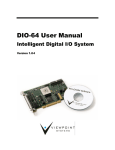Download DAQ VXI-SC-1102 User manual
Transcript
USING YOUR NI-DAQ SOFTWARE WITH YOUR VXI-DAQ MODULE Introduction These notes describe your options when using NI-DAQ for PC Compatibles version 5.1 or later with your VXI-data acquisition (VXI-DAQ) module. Note: The information in these release notes applies only to configurations using National Instruments VXIbus controllers. NI-DAQ for PC Compatibles version 5.1 supports the following VXI-DAQ products: • VXI-DIO-128 • VXI-MIO-64XE-10 • VXI-MIO-64E-1 • VXI-AO-48XDC • VXI-SC-1000 • VXI-SC-1102 • VXI-SC-1150 on the following operating systems: • Windows 95 • Windows NT 4.0 ComponentWorks ™, CVI ™, LabVIEW ™, MITE ™, NI-DAQ ™, NI-VISA ™, NI-VXI ™, VirtualBench ™, and VXIpc ™ are trademarks of National Instruments Corporation. Product and company names are trademarks or trade names of their respective companies. 321519B-01 © Copyright 1996, 1997 National Instruments Corp. All rights reserved. October 1997 Software Installation A typical installation includes these National Instruments driver software products: • NI-VXI • NI-VISA • NI-DAQ for PC Compatibles • VXIplug&play Instrument Driver and Soft Front Panels and one or more of these National Instruments application software packages and documentation: Note: • LabVIEW • LabWindows /CVI • ComponentWorks • VirtualBench ™ If you are using LabVIEW and are new to VXI and data acquisition, refer to the LabVIEW DAQ Basics Manual. Perform the following steps to install your software: 1. Verify that you have the correct version of NI-VXI installed on your computer. The necessary version number will vary with your configuration; Table 1 lists the possible controller and operating system combinations and the oldest version of NI-VXI you can use to create VXI-DAQ applications. To determine the version of NI-VXI you have installed on your computer, perform the following steps: a. If you are using a VXIpc-800/700 Series embedded controller, PCI-MXI-2 controller, or AT-MXI-2 controller, perform the following steps: ♦ Windows 95 Look for the NIVXIINT.DLL file in the \WINDOWS\SYSTEM directory. Right-click on the file and select Properties in the menu. This will bring up a properties box. Select the Version tab on the properties box to display the file version. 2 ♦ Note: Windows NT Look for the NIVXIINT.DLL file in the \WINDOWS\SYSTEM32 directory. Right-click on the file and select Properties in the menu. This will bring up a properties box. Select the Version tab on the properties box to display the file version. b. If you have a different controller, run VICTEXT. Type in the command version. Your NI-VXI version will be displayed. c. If you do NOT have the correct version of NI-VXI installed, install it at this time. See your NI-VXI documentation for specific installation instructions. The NI-DAQ CD includes versions of NI-VXI and NI-VISA that you can use with the VXIpc-800/700 Series, PCI-MXI-2, and AT-MXI-2 controllers. If your version of NI-VXI or NI-VISA is prior to the listed versions, you should install the correct version from the NI-DAQ CD. Table 1. NI-VXI Version Options Controller Windows 95 Windows NT 4.0 VXIpc-860 1.5.1 1.5.1 VXIpc-850 1.5 1.5 VXIpc-700 Series 1.5 1.5 PCI-MXI-2 1.5 1.5 AT-MXI-2 1.0* N/A (not supported) AT-MXI-1 3.3† 1.1 VXIpc-486, Model 500 Series 1.4 1.1 * Windows 3.1 driver version 1.0 with NI-VXI upgrade kit for Windows 95 † AT-MXI-1 driver revision 3.3 with NI-VXI upgrade to Windows 95 2. Verify that you already have NI-VISA 1.1 or later installed on your computer: a. Look for the VISA Interactive Control program in your VXIpnp folder. If you find the program, run it and open the About... dialog box to determine the NI-VISA version number. 3 If you do not find the program, perform the following steps: ♦ Windows 95 Look in the \WINDOWS\SYSTEM\ directory for the VISA32.DLL file. Right-click on the file and select Properties in the menu. This will bring up a properties box. Select the Version tab on the properties box to display the file version. ♦ Windows NT 4.x Look in the \WINNT\SYSTEM32\ directory for the VISA32.DLL file. Right-click on the file and select properties in the menu. This will bring up a properties box. Select the Version tab on the properties box to display the file version. b. If you do not have NI-VISA 1.1 or later installed, install it at this time. Refer to your NI-VISA documentation for specific instructions. 3. Install your application software using the appropriate documentation. 4. Install NI-DAQ version 5.1 or later on your computer, if it is not already installed. Use the NI-DAQ CD and release notes that were included with your VXI-DAQ hardware for NI-DAQ software and documentation installation instructions. If NI-DAQ is already installed, run the NI-DAQ Configuration Utility and check the title bar for the version number. If you have a version earlier than 5.1, replace it with version 5.1 or later. See your NI-DAQ release notes for installation instructions. 5. If you plan to use the VXIplug&play Instrument Driver, install it using the instructions in the Setup Utility on the diskettes that were included with your VXI-DAQ hardware. Your software installation is now complete. 4 Configuration Configuring Your VXIbus Controller After you install all your software, run the following configuration programs to configure your VXIbus system with NI-DAQ: • Note: Note: Run the Resource Manager, RESMAN, to initialize the VXIbus modules in your chassis. RESMAN is not an interactive utility. RESMAN assigns resources to the VXIbus modules in your chassis. You must run RESMAN every time you reset your VXIbus controller or VXIbus chassis. • Run VXIEDIT or Test & Measurement Explorer to configure your VXIbus controller. Read the section of this note that is appropriate for your VXIbus controller to configure your controller to use VXI-DAQ products. • Run the NI-DAQ Configuration Utility to configure your VXI-DAQ modules. More detailed information is in the Configuring Your VXI-DAQ Module with NI-DAQ section later in these release notes. You only need to run VXIEDIT or Test & Measurement Explorer when you configure your system for the first time or when you add or remove memory on your controller. You only need to run the NI-DAQ Configuration Utility when you add or remove VXI-DAQ modules or when you add or remove memory on your VXI-DAQ modules. Configuring VXIpc-800/700 Series Embedded Controllers ♦ Configuration using NI-VXI 1.5 and VXIEDIT 1. Launch VXIEDIT. 2. Choose the VXIpc Configuration Editor. 3. Select Load Configuration From File. 4. If you have a VXIpc-860 embedded controller, find \NIVXI\TBL\VDAQ860.CFG and select it. If you have a VXIpc-850 embedded controller, find \NIVXI\TBL\VDAQ850.CFG and select it. If you have a VXIpc-740 embedded controller, find \NIVXI\TBL\VDAQ740.CFG and select it. 5 5. Click on Load. 6. You should see a message that your Configuration Restored Successfully. 7. Select Update Current Configuration. After updating the EEPROM, return to the main menu. 8. If you are using VXI-MXI-2 extenders in your system, select the VXI/VME-MXI-2 Configuration Editor. 9. For each VXI-MXI-2 in your system, select the Enable Interlocked Mode field. 10. Reset your VXI chassis and rerun RESMAN. Note: After you have configured your controller, if you later add or remove memory on your controller, you must run VXIEDIT. Choose the Logical Address Configuration Editor. In the VXI Shared RAM Size control, select Share All of System Memory and click on OK. You must actually select the control even if its setting is already Share All of System Memory. Only by activating the control is the new memory size calculated. Then perform step 7. ♦ Configuration using NI-VXI 2.0 and Test & Measurement Explorer 1. Launch Test & Measurement Explorer. 2. In the System View window, right-click on the VXIpc controller icon. 3. Select Hardware Configuration from the pop-up menu. 4. Under the General tab, select VXI-DAQ Configuration from the Common Configurations menu. 5. Click on OK. 6. The utility will ask you to reboot. Click OK. 7. If you are using VXI-MXI-2 extenders in your system, right-click on the first extender shown in the System View window. 8. Under the General tab, select VXI-DAQ Configuration from the Common Configurations menu. 9. Repeat Step 8 for each VXI-MXI-2 extender in your system. 10. Reset your VXI chassis and run RESMAN. 6 Configuring PCI-MXI-2 Controllers ♦ Using NI-VXI 1.5 and VXIEDIT 1. Launch VXIEDIT. 2. Choose the PCI-MXI-2 Configuration Editor. 3. Select Load Configuration From File. 4. Select \NIVXI\TBL\VXIDAQ.CFG. 5. Click on Load. 6. You should see a message that your Configuration Restored Successfully. 7. Select Update Current Configuration. After updating the EEPROM, return to the main menu. 8. Select the VXI-MXI-2 Configuration Editor for each VXI-MXI-2 in your system by selecting a particular VXI-MXI-2 and clicking on OK. 9. Set the Interlocked field to Enable and click on OK. Repeat this step for each VXI-MXI-2 in your system. 10. Quit VXIEDIT and restart your computer. Power cycle your VXIbus chassis, then run RESMAN. Note: After you have configured your controller, if you later add or remove memory on your controller, you must run VXIEDIT. Choose the Logical Address Configuration Editor. In the VXI Shared RAM Size control, select Share All of System Memory and click on OK. You must actually select the control even if its setting is already Share All of System Memory. Only by activating the control is the new memory size calculated. Then perform step 7. 7 ♦ Using NI-VXI 2.0 and Test & Measurement Explorer 1. Launch Test & Measurement Explorer. 2. In the System View window, right click on the PCI-MXI-2 controller. 3. Select Hardware Configuration from the pop-up menu. 4. Under the General tab, select VXI-DAQ Configuration from the Common Configurations menu. 5. Click on OK. 6. The utility will ask you to reboot. Click OK. 7. Right-click on the first VXI-MXI-2 extender shown in the System View window. 8. Under the General tab, select VXI-DAQ Configuration from the Common Configurations menu. 9. Repeat Step 8 for each VXI-MXI-2 extender in your system. 10. Reset your VXI chassis and run RESMAN. Configuring VXIpc-486 Model 500 Series Embedded Controllers No additional configuration steps are necessary for these controllers. Configuring AT-MXI-2 and AT-MXI-1 Controllers No additional configuration steps are necessary for these controllers. Configuring the GPIB-VXI/C Controller No additional configuration steps are necessary for this controller. Configuring Your VXI-DAQ Module with NI-DAQ The NI-DAQ Configuration Utility identifies your VXI-DAQ module and configures its various operating settings. When using a VXIpc-740, VXIpc-850, VXIpc-860, or PCI-MXI-2, the NI-DAQ Configuration Utility automatically detects the VXI-DAQ modules installed in your system. For the configuration utility to automatically detect modules, you must have the modules installed in your VXIbus chassis, and you must have run the Resource Manager, RESMAN, before starting the NI-DAQ configuration utility. 8 To configure your new VXI-DAQ device for use by NI-DAQ, perform the following steps: 1. Run the NI-DAQ Configuration Utility. 2. The utility should now prompt you to configure a new device in your computer. Select a device number from the list of device numbers provided, and click OK. Note: If your VXI-DAQ device is not automatically detected, see the information on manually adding a device later in this section. Note: The device number is NOT the same as the VXIbus logical address for the module. 3. From the list of devices, select the number for the device you assigned in step 2. Click the Configure button. 4. If your device was automatically detected, the Logical Address field and the VXIbus Address Space are already filled in. If you manually added a device to your system, perform the following steps: a. b. Note: Using the Logical Address control, assign the module its logical address. This number MUST match the module DIP switch setting. • You cannot use this control to change the module logical address; you can use it only to associate an NI-DAQ device number to a logical address. • If you do not know the logical address for your module, RESMAN lists logical addresses as part of its output. Using the VXIbus Address Space control, assign the module a VXIbus address space. You can get the current address space as part of the RESMAN output. You can use this control to change the A24/A32 address space. You should select the A32 address space for your VXI-MIO modules. If you are using the GPIB-VXI/C, select the A24 address space. 5. Select the VXI Interrupt Request field to assign a VXIbus interrupt to your MIO module. You can choose any line for this setting. 6. Use the Apply button to verify your settings. If one or more of your settings is incorrect and the message Failed to set the resource is displayed, check your VXI-DAQ device settings. 7. Test your configuration by clicking the Test button. 9 8. If you get the message The device did not pass the test, check your VXI-DAQ device settings. 9. When finished testing your device, close the panel by clicking on OK. 10. Before exiting the NI-DAQ Configuration Utility, save the configuration by selecting the File»Save menu option. Your VXI-DAQ configuration is complete. If your VXI-DAQ device was not automatically detected, you can manually add the device to your configuration. To add a device, perform the following steps: ♦ ♦ Windows 95 1. Open the Control Panel folder and click on the Add New Hardware icon. 2. When prompted with Do you want Windows to search for your new hardware?, click on No. 3. If there is a Data Acquisition Devices heading, click on this. Otherwise, select Other Devices and choose National Instruments in the Manufacturer setting. 4. Select the VXI-DAQ module you have installed from the available choices. 5. When prompted, click on Finished. 6. Run the NI-DAQ Configuration Utility and perform the steps for configuring a new VXI-DAQ device as described in this note. Windows NT 1. Run the NI-DAQ Configuration Utility. 2. Click on the Add button and select the appropriate VXI-DAQ device from the displayed list. Follow the steps for configuring a new VXI-DAQ device as described in this note. 10 Configuring Your VXI-SC Submodule You must run RESMAN before starting the NI-DAQ Configuration Utility. Write down the VXI logical address assigned to each VXI-SC submodule, because the NI-DAQ Configuration Utility cannot automatically detect VXI-SC submodules. All VXI-SC submodules must be adjacent and to the right of a VXI-MIO device. For a VXI chassis oriented in the upright position (controller on the left), the VXI-SC submodule slots are numbered sequentially, first from top to bottom, then from left to right. To configure your new VXI-SC submodule for use by NI-DAQ, perform the following steps after configuring your VXI-MIO devices: 1. Run the NI-DAQ Configuration Utility. 2. Click on the SCXI Devices tab. 3. On the Chassis panel, click on the Add button and select VXI-SC. 4. Assign the chassis a Chassis ID and Chassis address. This does NOT have to match the VXI logical address. 5. On the Modules panel, click on the Add button and select any VXI-SC submodules you have installed. 6. A configuration dialog box will appear. Assign to the submodule the VXI logical address that you obtained from RESMAN. 7. There may be other configurable options, such as Connected to, Operating Mode, and selections for gains and accessories. Select these as you would for a conventional SCXI module in an external chassis. 8. Use the Apply button to verify your settings, then close the panel by clicking on the OK button. 9. Test your configuration by using the Test button. If you get the message, Failed to find VXI-SC-xxxx, check the settings of your VXI-SC submodule. 10. Before exiting the NI-DAQ Configuration Utility, save the configuration by selecting the File»Save menu option. 11 Programming Your VXI-DAQ Module This section provides an overview of the functions available for programming your VXI-DAQ modules. Additional information is available in the NI-DAQ Function Reference Manual for PC Compatibles. VXI-MIO Series Modules The VXI-MIO-64XE-10 is functionally equivalent to the AT-MIO-16XE-10. Any VI or function valid for the AT-MIO-16XE-10 is also valid for the VXI-MIO-64XE-10. The same relationship exists between the VXI-MIO-64E-1 and the AT-MIO-16E-1. The channel numbering scheme for both VXI-MIO Series modules is identical to that of the AT-MIO-64E-3. The few differences that do exist, such as onboard memory, are discussed in the Common Questions section of this document. VXI-DIO-128 Module The VXI-DIO-128 currently has no functionally equivalent DAQ hardware. The following sections list the LabWindows/CVI functions and LabVIEW VIs you will use to program your VXI-DIO-128. Note: You cannot change the direction of the digital lines on the VXI-DIO-128; 64 of the lines are always input and 64 are always output. LabWindows/CVI Functions Use the following functions to program the VXI-DIO-128 module. More detailed information about these functions is available in the NI-DAQ Function Reference Manual for PC Compatibles. DIG_Prt_Config • Ports 0–7 are always input ports and ports 8–15 are always output ports. • latchMode is not supported and must be set to 0. • You must set Direction to input for ports 0–7 and to output for ports 8–15. 12 DIG_In_Port • When the software reads output ports, the returned data is simply the last data written, and the returned status is the badChanDirError warning. DIG_Out_Port • Ports must be 8–15. DIG_Line_Config • Lines in ports 0–7 are always input lines and lines in ports 8–15 are always output lines. • There are eight lines per port numbered 0–7. • You must set Direction to input for lines in ports 0–7 and to output for lines in ports 8–15. DIG_In_Line • When the software reads output lines, the returned data is simply the last data written, and the returned status is the badDirOnSomeLinesError warning. DIG_Out_Line • Ports must be 8–15. Set_DAQ_Device_Info The VXI-DIO-128 supports an adjustable threshold for the input ports. The logical 0-to-logical 1 transition can occur anywhere in the range of -32.00 to +31.75 V in 250 mV steps. Set this threshold with the Set_DAQ_Device_Info function as shown in the following example, which sets the threshold of input port 3 to TTL level (1.5 V): status = Set_DAQ_Device_Info(device, ND_DIO128_SELECT_INPUT_PORT, 3); status = Set_DAQ_Device_Info(device, ND_DIO128_SET_PORT_THRESHOLD, 1500); The first Set_DAQ_Device_Info call selects which input port threshold to modify. The definitions for ND_DIO128_SELECT_INPUT_PORT and ND_DIO128_SET_PORT_THRESHOLD are in the NIDAQCNS include file. The value for ND_DIO128_SET_PORT_THRESHOLD is in millivolts. The input port thresholds of input ports 0–7 are automatically initialized 13 to the TTL level (1.5 V) whenever the NI-DAQ driver is loaded. Any changes you make will endure only for the life of the program. Get_DAQ_Device_Info In addition to its other functions, you can use Get_DAQ_Device_Info to get the current input port threshold as shown in the following example: err = Set_DAQ_Device_Info (device, ND_DIO128_SELECT_INPUT_PORT, 3); err = Get_DAQ_Device_Info (device, ND_DIO128_GET_PORT_THRESHOLD, &port3threshold); The value returned will be in millivolts. LabVIEW VIs Use the following LabVIEW VIs—DIO Port Config, DIO Port Read, DIO Port Write, and DIO Parameter—to program the VXI-DIO-128 module. DIO Port Config • Ports 0–7 are input ports and ports 8–15 are output ports. • Every line within a port must have the same direction (for instance, all input or all output). • The physical port width is 8 bits. You can combine up to four consecutive ports into a 32-bit port. DIO Port Read • When the software reads the output lines, the returned data is simply the last data written, and the returned status is the badDirOnSomeLinesError warning. DIO Port Write You can write only to ports 8–15. DIO Parameter • You can use the GET operation on a particular input port to obtain that port’s current logic threshold. • You can use the SET operation on a particular input port to change that port’s current logic threshold. 14 VXI-AO-48XDC Module The VXI-AO-48XDC programming model is very similar to the AO-2DC device. Any function or VI valid for the AO-2DC is also valid for the VXI-AO-48XDC. Furthermore, the Set_DAQ_Device_Info function and the AO Parameter VI provide support for changing this device’s power-on state. Additional information is available in the NI-DAQ Function Reference Manual for PC Compatibles. Set_DAQ_Device_Info The following example shows how to use this function to save the current values of the voltage and current channels as the power-on values: status = Set_DAQ_Device_Info(device, ND_AO48XDC_SET_POWERUP_STATE, ND_NODE); AO Parameter VI • You can use the Save power-on state option to save the current values of the voltage and current channels as the power-on values. Common Questions 1. When I attempt to save my configuration in the NI-DAQ Configuration Utility, I receive a dialog box that says The device is not responding to the selected base address. What does this mean? If you followed the steps in the Software Installation and Configuration sections of these release notes and you get this message, most likely it means that an incorrect VXI Logical Address is specified. Please verify that the displayed logical address matches the logical address set by the device DIP switch. Additionally, it may mean that you have forgotten to run RESMAN. With the VXI-MIO boards, another possibility is that your EEPROM may be incorrect. The VXI-MIO boards need at least 4 KB of VXI address space to function properly. Check the amount of space your board is requesting by launching VXIEDIT and selecting your VXI-MIO from the list of available boards. If the address size is less than 4 KB (0X1000 B), repair your EEPROM. 15 To repair your EEPROM, perform the following steps: a. Power down your chassis and remove your VXI-MIO board from the system. b. Change switch S2 to the Load Factory Configuration setting. c. Reinstall your board into the system and power on your chassis. d. Run RESMAN and launch the NI-DAQ Configuration Utility. e. Select your VXI-MIO board from the list of devices and click on Configure. f. Set the address space and onboard memory fields to your desired settings and click on Apply. g. Exit the NI-DAQ Configuration Utility. h. Power down your chassis, remove your MIO board, and set switch S2 to the Load User Configuration setting. Your EEPROM settings are now restored. The VXI-MIO devices are bus mastering boards and they generate VXI interrupts. Some VXI chassis require jumper settings for the interrupt acknowledge and bus arbitration signals. Ensure that the ACK signal and bus arbitration jumpers are removed from between the slots that the VXI modules occupy and are present between the slots that are empty. Refer to your mainframe documentation for more information. To test your configuration, try installing the VXI-MIO device adjacent to the VXI controller (slot 1). 2. When I attempt to save my configuration in the NI-DAQ Configuration Utility, I receive a dialog box that says The device is not responding to the first IRQ level. What does this mean? If you followed the steps in the Software Installation and Configuration sections of these release notes and you get this message, most likely it means that your controller does not provide kernel mode access and cannot handle interrupts from your VXI-DAQ board. See question 6 for more information about kernel mode access. 3. When I attempt to save my configuration in the NI-DAQ Configuration Utility, I receive a dialog box that says The device is not responding to the first DMA channel. What does this mean? This message is returned when the NI-DAQ Configuration Utility attempts to perform a DMA transfer from the board to your VXI controller. If you followed the steps in the Software Installation and Configuration sections of these release notes and you get this 16 message, most likely it means that you failed to configure your VXI controller correctly. If you added additional memory to your VXI controller without reconfiguring your controller, you may receive this error. See the sections, Configuring VXIpc-860, VXIpc-850, and VXIpc-740 Embedded Controllers and Configuring PCI-MXI-2 Controllers, earlier in this document for the steps to configure your controller when adding additional memory. 4. When I attempt to save my configuration in the NI-DAQ Configuration Utility, I receive a dialog box that says The device did not pass the test. What does this mean? If you followed the steps in the Software Installation and Configuration sections of these release notes and you get this message, most likely it means that you failed to configure your VXI controller correctly. 5. How do I know my VXI-DAQ module is installed and working? After following the installation and configuration steps, run the NI-DAQ Configuration Utility. After opening the program, click on the entry for your VXI-DAQ module. When the second window appears, click on the Test Resources button. If the device passes the test, a message box will appear that states The device has passed the test. The tests are interactive and test the A/D converter, the D/A converter, the digital I/O lines, and the counter/timers. Additionally, if you installed the VXIplug&play instrument driver, the soft front panels included with the instrument driver are also useful in verifying that your module is working. 6. What is meant by kernel mode access and what do I need to know about it? NI-DAQ handles all interrupts in kernel mode. However, old versions of NI-VXI or NI-VISA can prevent NI-DAQ from communicating with your VXI-DAQ module in kernel mode. Furthermore, certain controllers do not provide all of the necessary hardware support for kernel mode access. The following controllers do NOT provide the necessary hardware support: AT-MXI-1, AT-MXI-2, VXIpc-486 Model, 500 Series Embedded, GPIB-VXI, and third-party controllers. When NI-DAQ is denied kernel mode access, it is unable to perform some buffered operations, such as waveform capture. It can still perform immediate operations, such as AI_VRead in LabWindows/CVI, or AI Single Scan and timed, nonbuffered 17 operations in LabVIEW. The VXI-DIO-128 and the VXI-AO-48XDC do not require kernel mode access and are completely functional without it. 7. How do I know that NI-DAQ has kernel mode access? If you attempt an operation on a VXI-DAQ module that requires NI-DAQ to communicate with your module at interrupt time, such as buffered waveform capture, and NI-DAQ does not have kernel mode access to the module, your application will receive the deviceSupportError. See Question 6 for more information. 8. Is there anything I can do about a kernel mode access problem? One way to solve a kernel mode access problem is to use onboard memory on the VXI-MIO module. Timed, buffered analog input (waveform capture) without kernel mode access is possible only if you have onboard memory. Timed, buffered analog output (waveform generation) is possible even when kernel mode access is denied. However, the iteration count will be unavailable and the regeneration modes are unsupported. You can use either host or onboard memory for your waveform generation, even when NI-DAQ does not have kernel mode access. Timed, buffered counter/timer input is not available without kernel mode access. Only one operation at a time can use onboard memory. That is, you can acquire analog input data into the onboard memory, but you cannot simultaneously generate a waveform from data in that onboard memory. The VXI-MIO Series modules support onboard memory only in LabVIEW and LabWindows/CVI. See Question 9 for more information about onboard memory. 9. How do I specify the use of onboard memory in my program? The VXI-MIO Series modules support onboard memory only in LabVIEW and LabWindows/CVI. First, you must tell NI-DAQ via the NI-DAQ Configuration Utility that you have installed onboard memory. See the Installation chapter of your VXI-DAQ device user manual for more information. The onboard memory is on the VXI-DAQ module itself, not on the VXIbus controller. Select the amount of onboard memory you intend to use via the VXI onboard memory field in the NI-DAQ Configuration Utility. Select A32 address space for your module if your controller allows it. After 18 making these changes in the NI-DAQ Configuration Utility, reset or power cycle your VXIbus chassis, and run RESMAN. Next, set your LabVIEW application to use onboard memory at run time. For analog input, set the allocation mode control in the AI Config VI to 3; allocate DSP Memory. For analog output, set the allocate mode control in AO Config VI to 4; allocate DSP Memory. Ignore the text referring to DSP Memory and the AT-DSP2200 module. Under LabWindows/CVI, the VXI-MIO series modules support onboard memory only when using the Easy I/O for DAQ library. To use the onboard memory, open the Set Device Information function, which is located in the Initialization/Utilities section of the Data Acquisition Library. Specify the Select VXI-MIO Memory Allocation Mode choice for the Type of Information field. Select the desired memory allocation mode from the choices available in the Information Value field. For example, to use onboard memory for waveform capture, select the Use Onboard Memory for VXI-MIO AI option. Note that these settings apply on a per-module basis. A constraint is placed on analog input operations that use onboard memory when kernel mode access is denied—you cannot acquire more data than the buffer that you allocated in the onboard memory can hold. For example, if your buffer is 1,000 scans in size, you can acquire no more than 1,000 scans. Continuous acquisition is not allowed under these conditions. Note: You will be unable to utilize a buffer as large as the memory that you installed because 6 KB of this memory is reserved and unavailable for your use. 10. What exactly does the VXI-DAQ configuration file (VXIDAQ.CFG, VDAQ860.CFG, VDAQ850.CFG, VDAQ740.CFG) do to my VXIEDIT configuration? For all controllers, the VXI-DAQ configuration file sets your controller address space to A32, sets the Byte Order to Non-Swapped, and sets Slave Write Posting to Enable. The PCI-MXI-2 VXI-DAQ configuration file will also point retries caused by CPU-MXI collisions towards the MXIbus, and set MXI Auto Retry to disable. The VXIpc-700 Series VXI-DAQ configuration file will point retries caused by CPU-VXI collisions toward the VXIbus and set VXI Auto Retry to Disable. 19 11. How do I use SCXI with my VXI-MIO module? Simply follow the procedures outlined in your NI-DAQ documentation for MIO E Series devices. Using SCXI with your VXI-MIO module is no different than using SCXI with any other MIO E Series device. 12. Are there any module features described in my VXI-DAQ user manuals that may not be supported in NI-DAQ? For the VXI-DIO-128 and the VXI-AO-48XDC modules, NI-DAQ 5.1 does not support Serial Number EPROM or Temperature Sensor features. 13. When I attempt to use the regeneration modes for waveform generation, why do I receive the -10004 (valueConflictError) error? Waveform regeneration modes (regeneration mode values 2 and 3 in the AO Buffer Write VI in LabVIEW and oldDataStop value 1 and partialTransferStop value 1 in WFM_DB_Config) are supported on the VXI-MIO modules only when you use interrupts to send the waveform data to the module. Since the default transfer mode for waveform generation uses DMA, use the Set DAQ Device Information VI in LabVIEW or the Set_DAQ_Device_Info function in the C language interface to switch to using interrupts. Also notice that if kernel mode access is denied, the regeneration modes will never be available, since you can only use DMA in this case. 14. I am using an embedded controller and when I attempt to test the resources, the NI-DAQ Configuration Utility stops responding. What is wrong? The address map for your controller might be incorrect. Run RESMAN and note the amount of memory requested by your controller. If the amount of memory requested does not match the actual amount of memory in the embedded controller, you need to reconfigure your controller. a. Launch VXIEDIT. b. Choose VXIpc Configuration Editor. c. Choose Logical Address Configuration Editor. d. Change the VXI Shared Ram Size to the amount of RAM in the controller. e. Click on OK. 20 f. Select Update Current Configuration. After updating the EEPROM, return to the Logical Address Configuration Editor. g. Change the VXI Shared Ram Size to All of System Ram. h. Click on OK. i. Select Update Current Configuration. After updating the EEPROM, return to the main menu. j. Quit VXIEDIT and restart your machine. Rerun RESMAN to verify that the amount of requested memory now matches the amount of memory in the controller. 21
































